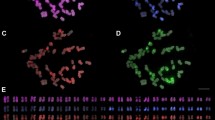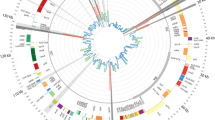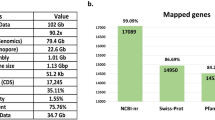Abstract
Gene and genome duplication events have long been accepted as driving forces in the evolution of angiosperms. Panax ginseng C. A. Meyer and Panax quinquefolius L., which inhabit eastern Asia and eastern North America, respectively, are famous medicinal herbs and are similar in growth condition, morphological and genetic characteristics. However, no molecular data regarding their evolution has been available. In this study, expressed sequence tags (ESTs) were generated from a cDNA library of P. ginseng and comparative analyses were conducted to reveal genome-level duplication and speciation of P. ginseng and P. quinquefolius by in-depth comparison of paralog and orthlog ESTs. Sequencing and assembly of 5,760 clones from the cDNA library resulted in 4,552 uniESTs of P. ginseng and these were subjected to initial annotation steps. Comparative analysis was conducted with the uniESTs and transcriptome data of P. quinquefolius retrieved from the public database. Paralog pairing and analysis of the distribution of synonymous substitutions per synonymous site (Ks) showed two coincident peaks in both Panax species, implying two rounds of genome duplication in their common ancestor. Comparison of orthologs revealed one Ks peak that is younger than the two peaks identified from the analysis of paralogs. However, absolute dating of genome duplication and speciation events is needed to address caveats related to their long generation times, speculated to be more than 8–10 years in the wild. This is the first report regarding the evolutionary relationship of Panax species at the genome-wide level, and will provide a foundation to unravel the genome structure of the enigmatic genus Panax and the family Araliaceae.



Similar content being viewed by others
References
Altschul SF, Madden TL, Schaffer AA, Zhang JH, Zhang Z, Miller W, Lipman DJ (1997) Gapped BLAST and PSI-BLAST: a new generation of protein database search programs. Nucleic Acids Res 25:3389–3402
Artyukova EV, Gontcharov AA, Kozyrenko MM, Reunova GD, Zhuravlev YN (2005) Phylogenetic relationships of the far eastern Araliaceae inferred from ITS sequences of nuclear rDNA. Genetika 41:649–658
Asamizu E, Nakamura Y, Sato S, Tabata S (2000) A large scale analysis of cDNA in Arabidopsis thaliana: generation of 12,028 non-redundant expressed sequence tags from normalized and size-selected cDNA libraries. DNA Res 7:175–180
Attele AS, Wu JA, Yuan CS (1999) Ginseng pharmacology: multiple constituents and multiple actions. Biochem Pharmacol 58:1685–1693
Barker MS, Kane NC, Matvienko M, Kozik A, Michelmore W, Knapp SJ, Rieseberg LH (2008) Multiple paleopolyploidizations during the evolution of the Compositae reveal parallel patterns of duplicate gene retention after millions of years. Mol Biol Evol 25:2445–2455
Blair A (1975) Karyotype of five plant species with disjunct distributions in Virginia and the Carolinas. Am J Bot 62:833–837
Blanc G, Wolfe KH (2004) Widespread paleopolyploidy in model plant species inferred from age distributions of duplicate genes. Plant Cell 16:1667–1678
Boufford DE, Spongberg SA (1983) Eastern Asian-eastern North American phytogeographical relationships-a history from the time of Linnaeus to the twentieth century. Ann Mo Bot Gard 70:423–439
Choi HK, Wen J (2000) A phylogenetic analysis of Panax (Araliaceae): integrating cpDNA restriction site and nuclear rDNA ITS sequence data. Plant Syst Evol 224:109–120
Choi HW, Koo DH, Bang KH, Paek KY, Seong NS, Bang JW (2009) FISH and GISH analysis of the genomic relationships among Panax species. Genes Genomics 31:99–105
Choi HI, Kim NH, Jung JY, Park HM, Park HS, Park JY, Lee J, Park J, Lee J, Choi BS, Ahn IO, Lee JS, Choi D,Yang TJ (2010) Current status of Korean ginseng (Panax ginseng) genome mapping and sequencing. In: Yang DC, Kim SK (eds) Advances in Ginseng Research—proceedings of 10th international symposium on Ginseng: 13–16 Sep 2010, The Korean Society of Ginseng, Seoul, pp 762–778
Choi HI, Kim NH, Kim JH, Choi BS, Ahn IO, Lee JS, Yang TJ (2011) Development of reproducible EST-derived SSR markers and assessment of genetic diversity in Panax ginseng cultivars and related species. J Ginseng Res 35:399–412
Conesa A, Gotz S (2008) Blast2GO: a comprehensive suite for functional analysis in plant genomics. Int J Plant Genomics 2008:619832
Cui L, Wall PK, Leebens-Mack JH, Lindsay BG, Soltis DE, Doyle JJ, Soltis PS, Carlson JE, Arumuganathan K, Barakat A, Albert VA, Ma H, dePamphilis CW (2006) Widespread genome duplications throughout the history of flowering plants. Genome Res 16:738–749
DeChaine EG (2008) A bridge or a barrier? Beringia’s influence on the distribution and diversity of tundra plants. Plant Ecol Div 1:197–207
Fawcett JA, Maere S, Van de Peer Y (2009) Plants with double genomes might have had a better chance to survive the Cretaceous-Tertiary extinction event. Proc Natl Acad Sci USA 106:5737–5742
Gaut B, Yang L, Takuno S, Eguiarte LE (2011) The patterns and causes of variation in plant nucleotide substitution rates. Ann Rev Ecol Evol Syst 42:245–266
Guo Q (1999) Ecological comparisons between Eastern Asia and North America: historical and geographical perspectives. J Biogeography 26:199–206
Ha WY, Shaw PC, Liu J, Yau FCF, Wang J (2002) Authentication of Panax ginseng and Panax quinquefolius using amplified fragment length polymorphism (AFLP) and directed amplification of minisatellite region DNA (DAMD). J Agric Food Chem 50:1871–1875
Harn C, Whang J (1963) Development of female gametophyte of Panax ginseng. Korean J Bot 6:3–6
Hopkins DM (1967) The Bering land bridge. Stanford University Press, Stanford
Huang XQ, Madan A (1999) CAP3: a DNA sequence assembly program. Genome Res 9(9):868–877
Kim C, Jang CS, Kamps TL, Robertson JS, Feltus FA, Paterson AH (2008) Transcriptome analysis of leaf tissue from Bermudagrass (Cynodon dactylon) using a normalised cDNA library. Funct Plant Biol 35:585–594
Kim JH, Jung JY, Choi HI, Kim NH, Park JY, Lee Y, Yang TJ (2012a) Diversity and evolution of major Panax species revealed by scanning the entire chloroplast intergenic spacer sequences. Genet Resour Crop Evol. doi:10.1007/s10722-012-9844-4
Kim NH, Choi HI, Ahn IO, Yang TJ (2012b) EST-SSR marker sets for practical authentication of all nine registered ginseng cultivars in Korea. J Ginseng Res 36:298–307
Kimura M (1980) A simple method for estimating evolutionary rates of base substitutions through comparative studies of nucleotide sequences. J Mol Evol 16:111–120
Ko KM, Song JJ, Hwang B, Kang YH (1993) Cytogenetic and histological characteristics of ginseng hairy root transformed by Agrobacterium rhizogenes. Korean J Bot 36:75–81
Kondo K, Taniguchi K, Tanaka R, Gu ZJ (1992) Karyomorphological studies in Chinese plant-species involving the Japanese floristic element, I, American Camellia Yearbook 1992, pp 131–156
Kuhl JC, Cheung F, Yuan Q, Martin W, Zewdie Y, McCallum J, Catanach A, Rutherford P, Sink KC, Jenderek M, Prince JP, Town CD, Havey MJ (2004) A unique set of 11,008 onion expressed sequence tags reveals expressed sequence and genomic differences between the monocot orders Asparagales and Poales. Plant Cell 16:114–125
Larkin MA, Blackshields G, Brown NP, Chenna R, McGettigan PA, McWilliam H, Valentin F, Wallace IM, Wilm A, Lopez R, Thompson JD, Gibson TJ, Higgins DG (2007) Clustal W and clustal X version 2.0. Bioinformatics 23:2947–2948
Lee C, Wen J (2004) Phylogeny of Panax using chloroplast trnC-trnD intergenic region and the utility of trnC-trnD in interspecific studies of plants. Mol Phylogenet Evol 31:894–903
Li HL (1952) Floristic relationships between eastern Asia and eastern North America. Trans Am Philos Soc 42:371–429
Li WH (1997) Molecular evolution. Sinauer Associates, Sunderland
Li FC, Sun X, Gong XC (1985) The analysis of the chromosomal morphology and Giemsa C-banding pattern in Ginseng. Sci Agric Sin 5:31–35
Lynch M, Conery JS (2000) The evolutionary fate and consequences of duplicate genes. Science 290:1151–1155
Maere S, De Bodt S, Raes J, Casneuf T, Van Montagu M, Kuiper M, Van de Peer Y (2005) Modeling gene and genome duplications in eukaryotes. Proc Natl Acad Sci USA 102:5454–5459
Nagaraj SH, Gasser RB, Ranganathan S (2007) A hitchhiker’s guide to expressed sequence tag (EST) analysis. Brief Bioinform 8:6–21
Natarajan P, Kanagasabapathy D, Gunadayalan G, Panchalingam J, Shree N, Sugantham PA, Singh KK, Madasamy P (2010) Gene discovery from Jatropha curcas by sequencing of ESTs from normalized and full-length enriched cDNA library from developing seeds. BMC Genomics 11:606
Oh JH, Sohn HY, Kim JM, Kim YS, Kim NS (2004) Construction of multi-purpose vectors, pCNS and pCNS-D2, are suitable for collection and functional study of large-scale cDNAs. Plasmid 51:217–226
Ohno S (1970) Evolution by gene duplication. Springer, New York
Pandey A, Lewitter F (1999) Nucleotide sequence databases: a gold mine for biologists. Trends Biochem Sci 24:276–280
Persons WS (1994) American ginseng: green gold. Bright Mountain Books, Asheville
Qian H, Ricklefs RE (2000) Large-scale processes and the Asian bias in species diversity of temperate plants. Nature 407:180–182
Ralph SG, Chun HJ, Cooper D, Kirkpatrick R, Kolosova N, Gunter L, Tuskan GA, Douglas CJ, Holt RA, Jones SJ, Marra MA, Bohlmann J (2008) Analysis of 4,664 high-quality sequence-finished poplar full-length cDNA clones and their utility for the discovery of genes responding to insect feeding. BMC Genomics 9:57
Raven PH (1972) Plant species disjunctions: a summary. Ann Mo Bot Gard 59:234–246
Ren Y, Xu Q, Piao T, Sun B (1994) Karyotype analysis of American ginseng. J Jilin Agric Univ 16:43–46
Sanzol J (2010) Dating and functional characterization of duplicated genes in the apple (Malus domestica Borkh.) by analyzing EST data. BMC Plant Biol 10:87
Schlueter JA, Dixon P, Granger C, Grant D, Clark L, Doyle JJ, Shoemaker RC (2004) Mining EST databases to resolve evolutionary events in major crop species. Genome 47:868–876
Sharma SK, Bisht MS, Pandit MK (2010) Synaptic mutation-driven male sterility in Panax sikkimensis Ban. (Araliaceae) from Eastern Himalaya, India. Plant Syst Evol 287:29–36
Soltis DE, Albert VA, Leebens-Mack J, Bell CD, Paterson AH, Zheng CF, Sankoff D, dePamphilis CW, Wall PK, Soltis PS (2009) Polyploidy and angiosperm diversification. Am J Bot 96:336–348
Stebbins GL (1966) Chromosomal variation and evolution. Science 152:1463–1469
Sterck L, Rombauts S, Jansson S, Sterky F, Rouze P, Van de Peer Y (2005) EST data suggest that poplar is an ancient polyploid. New Phytol 167:165–170
Sticher O (1998) Getting to the root of ginseng. ChemTech 28:26–32
Sugiura T (1936) A list of chromosome numbers in angiospermous plants. II. Proc Imp Acad 12:144–146
Sun C, Li Y, Wu Q, Luo H, Sun Y, Song J, Lui EM, Chen S (2010) De novo sequencing and analysis of the American ginseng root transcriptome using a GS FLX Titanium platform to discover putative genes involved in ginsenoside biosynthesis. BMC Genomics 11:262
Suyama M, Torrents D, Bork P (2006) PAL2NAL: robust conversion of protein sequence alignments into the corresponding codon alignments. Nucleic Acids Res 34:W609–W612
Swarbreck D, Wilks C, Lamesch P, Berardini TZ, Garcia-Hernandez M, Foerster H, Li D, Meyer T, Muller R, Ploetz L, Radenbaugh A, Singh S, Swing V, Tissier C, Zhang P, Huala E (2008) The Arabidopsis Information Resource (TAIR): gene structure and function annotation. Nucleic Acids Res 36:D1009–D1014
Thorne RF (1972) Major disjunctions in the geographic ranges of seed plants. Q Rev Biol 47:365–411
Tuskan GA, Difazio S, Jansson S, Bohlmann J, Grigoriev I, Hellsten U, Putnam N, Ralph S, Rombauts S, Salamov A, Schein J, Sterck L, Aerts A, Bhalerao RR, Bhalerao RP, Blaudez D, Boerjan W, Brun A, Brunner A, Busov V, Campbell M, Carlson J, Chalot M, Chapman J, Chen G, Cooper D, Coutinho PM, Couturier J, Covert S, Cronk Q et al (2006) The genome of black cottonwood, Populus trichocarpa (Torr. & Gray). Science 313:1596–1604
Wen J (1999) Evolution of eastern Asian and eastern North American disjunct distributions in flowering plants. Annu Rev Ecol Syst 30:421–455
Wen J, Zimmer EA (1996) Phylogeny and biogeography of Panax L. (the ginseng genus, Araliaceae): inferences from ITS sequences of nuclear ribosomal DNA. Mol Phylogenet Evol 6:167–177
Wen J, Plunkett GM, Mitchell AD, Wagstaff SJ (2001) The evolution of Araliaceae: a phylogenetic analysis based on ITS sequences of nuclear ribosomal DNA. Syst Bot 26:144–167
Yang DQ (1981) The cyto-taxonomic studies on some species of Panax L. Acta Phytotax Sin 19:298–303
Yang ZH (1997) PAML: a program package for phylogenetic analysis by maximum likelihood. Comput Appl Biosci 13:555–556
Yang D, Tang ZH, Zhang LP, Zhao CP, Zheng YL (2009) Construction, characterization, and expressed sequence tag (EST) analysis of normalized cDNA library of thermo-photoperiod-sensitive genic male sterile (TPGMS) wheat from spike developmental stages. Plant Mol Biol Rep 27:117–125
Yi T, Lowry PP, Plunkett GM, Wen J (2004) Chromosomal evolution in Araliaceae and close relatives. Taxon 53:987–1005
Zhu S, Fushimi H, Cai S, Komatsu K (2003) Phylogenetic relationship in the genus Panax: inferred from chloroplast trnK gene and nuclear 18S rRNA gene sequences. Planta Med 69:647–653
Acknowledgments
This study was supported by the Mid-career Researcher Program through a National Research Foundation of Korea (NRF) grant funded by the Ministry of Education, Science and Technology (MEST) (No. R01-2007-000-20823-0) and a grant from the Next-Generation BioGreen 21 Program (No. PJ008202), Rural Development Administration, Republic of Korea, and partially supported by grant 2007-04269 from the MEST.
Author information
Authors and Affiliations
Corresponding author
Electronic supplementary material
Below is the link to the electronic supplementary material.
Rights and permissions
About this article
Cite this article
Choi, HI., Kim, NH., Lee, J. et al. Evolutionary relationship of Panax ginseng and P. quinquefolius inferred from sequencing and comparative analysis of expressed sequence tags. Genet Resour Crop Evol 60, 1377–1387 (2013). https://doi.org/10.1007/s10722-012-9926-3
Received:
Accepted:
Published:
Issue Date:
DOI: https://doi.org/10.1007/s10722-012-9926-3




